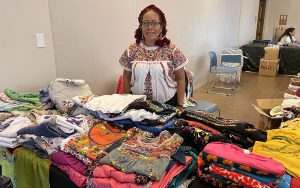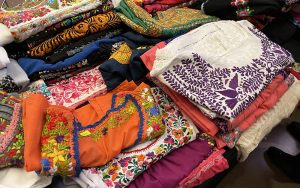PHOENIX – Drums begin to roll before trumpets, clarinets and a cadre of other instruments squeal in unison to kick off the Guelaguetza, a colorful Indigenous celebration of music, dance and food dating back centuries in southern Mexico.
The Guelaguetza (ghel-uh-GET-zuh) was celebrated at the Desert Botanical Garden the first weekend of October as a way to share Oaxacan culture in metro Phoenix.
More than 80 people from outside Phoenix participated in the celebration, which included music, dancing, food and artisans from Oaxaca and California, event organizers said. Surrounded by the garden’s trees and succulents, the audience was engaged during the hours-long performance and, at times, cheered and yelled encouragement.

Erika Santiago, a Oaxacan artisan, sells hand-embroidered clothing for Taller Familiar Severa Santiago at the Guelaguetza held at the Desert Botanical Garden on Oct. 1. (Photo by Jennifer Sawhney/Cronkite News)
“I am very happy because this is my first time here,” said Erika Santiago, who was selling colorful, hand-embroidered clothing and sneakers for Taller Familiar Severa Santiago. It’s a collaborative workshop in San Antonino Castillo Velasco, Oaxaca, which she helps run.
Santiago said more than 150 artisans contribute to making “dresses, tops and everything hand-embroidered” at Taller Familiar Severa Santiago.
The garden’s celebration of Guelaguetza – the Zapotec word for sharing and cooperating – allows Santiago to introduce Oaxacan handiwork as far away as Phoenix. For her, Guelaguetza is not just selling goods at a weekend event. This is part of an ongoing, multigenerational effort that engages the talents of hundreds of participants.
“There are pieces that we make in a day, in a week, in months and in years,” she said.
Santiago is the fifth of six generations in her family making hand-embroidered clothing. She has fond memories watching her grandparents cut cloth, draw designs with pen and embroider clothing that has lasted generations.
Other vendors at the Phoenix event, most of whom came from Oaxaca, sold handmade jewelry, traditional food staples, such as bread and tlayudas – a large, Oaxacan-style corn tortilla – and a variety of decorative skulls.
From Oaxaca to Phoenix
The Guelaguetza, which is traditionally celebrated throughout July in the city of Oaxaca, has pre-Hispanic roots of Zapotec origin. Dancers and musicians from Oaxaca’s eight regions perform at the Auditorio Guelaguetza, an open-air auditorium that’s been the celebration’s center stage since 1974.

More than 150 artisans contribute to the hand-sewn clothing made by Taller Familiar Severa Santiago, which is based in San Antonino Castillo Velasco, Oaxaca. (Photo by Jennifer Sawhney/Cronkite News)
Outside the Auditorio Guelaguetza, vendors line the streets selling clothing, jewelry and an array of food, much like the offerings at the Desert Botanical Garden.
The event’s Phoenix counterpart was organized by Elizabeth Hernández and her two children, Ricardo and Rebeca Santiago. The first two were held indoors in 2018 and 2019 in north Phoenix, but the celebration was canceled in 2020 and 2021 because of the pandemic.
Hernández owns Las 15 Salsas Restaurant Oaxaqueño, which she opened in north Phoenix after she noticed that, despite the large Mexican-American community in the Phoenix area, there were few places that offered the distinctive cuisine of southern Mexico. After she opened her restaurant, she saw an opportunity to bring even more of her Oaxacan culture to the Valley.
“Oaxaca is so rich in culture, in gastronomy, in architecture, in music. Why not make and bring something so people can understand it?” she said. “And that is how the idea of bringing the Guelaguetza was born.”
She and her children own two other businesses in north Phoenix that honor their Oaxacan roots: Guelaguetza Productos Oaxaqueños and Alebrije, a dessert shop. Alebrije refers to hand-carved wooden figurines made by Oaxacan artisans.
Ricardo Santiago said Phoenix’s summer heat prompted the move to October, when the celebration could be held outdoors. That “outdoor component” was important, he said, because it mirrors the open-air event in Oaxaca.
Community is life
Jenny Robles, director of Centeotl Danza y Baile, a Oaxacan dance troupe from Santa Cruz, California, also celebrated the Guelaguetza at the Desert Botanical Garden.
“The dances show what we do, how we conduct ourselves and how we party,” she said. “We’re telling a story through dance.”

Dancers and audience members dance together at the conclusion of the Guelaguetza at the Desert Botanical Garden. (Photo by Jennifer Sawhney/Cronkite News)
Dancers waved colorful dresses, stomped their feet and performed funny skits as Lico Music Academy from Los Angeles played.
Robles said she travels to Oaxaca to consult with teachers because it’s important she and her troupe maintain long-standing traditions.
“We take pride in the work we do,” she said. “It’s making a difference in the community. It’s making an awareness of our culture. We teach people to have tolerance of our culture and have self-esteem.”
The community-centered approach to sharing the culture is a crucial aspect of the Guelaguetza’s longevity.
Robles, like Erika Santiago follows the same methodical practice within their local communities: studying and sharing their crafts, honoring their work in everyday life and passing on the joy and commitment to subsequent generations. In Phoenix, Hernández and her children have done the same.
This is “hopefully the first of many” Guelaguetzas to come at the garden, Ricardo Santiago said. For him, the goal is simple: “to bring our culture to Arizona, our new home.”
